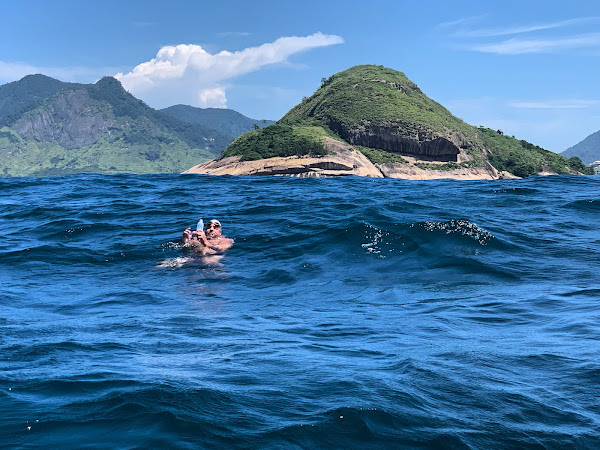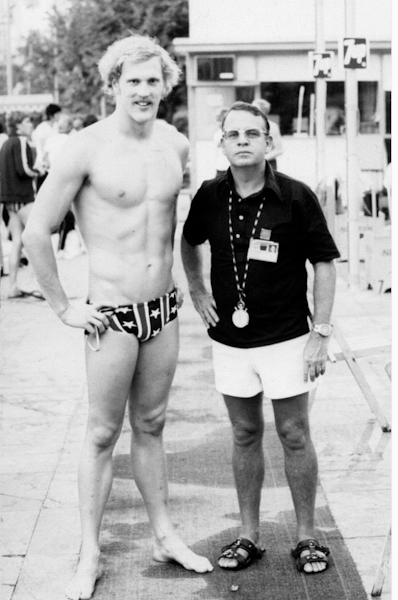Trail Running of the Sea - Improving Your Feel for the Ocean Amid Turbulence
It is not rare that channel swimmers and marathon swimmers get an upset stomach in turbulent conditions. It is highly probable that these swimmers swallow water in the surface chop, waves, and swells.
Over time as the swim and turbulence continues - sometimes hour after hour - it is inevitable that the swimmer has swallowed several (dozens) of gasps of saltwater. Mixed in with their normal feedings, an upset stomach is the end result.
Many (most?) swimmers can deal with this upset stomach and eventually finish their swim or crossing, but a handful of swimmers have to call it a day and abort their swim.
On the other end of the spectrum are experienced ocean and sea swimmers who - no matter how turbulent and wavy the conditions are - never or very rarely swallow a bit of saltwater.
How do they do that? How do these swimmers interact with a choppy ocean or rough sea and breathe - sometimes as many as 30 times per minute - without inadvertently swallowing any water?
For those who tend to mistime their breaths and repeatedly swallow water in bumpy water, this ability to avoid swallowing water seems unfathomable. But the inherent ability to swim without swallowing water can be learned and should be practiced.
There are many ways to practice and learn how to swim rhythmically with a turbulent sea. But these six means must be intentional and purposefully planned.
1. Enjoy bodysurfing.
2. Workout in (very) windy conditions.
3. Swim with, against, and laterally the currents and winds.
4. Practice in the surf (wave) zone, swimming parallel to the shore where the waves wash over you every 8-15 seconds.
5. Find a wide, open area to swim in (without other boaters or swimmers) and swim 1-2 minutes with your eyes closed.
6. Learn how to efficiently swim up and down large ocean swells.
With hours of practice, you will find that the randomness of the waves will not catch you off-guard, saving you from unintentionally swallowing water on your big/race day.
Over time, you will find yourself swallowing fewer and fewer gulps of water. Practice will make perfect.
Bruckner Chase coined the phrase that ocean swimming is the Trail Running of the Sea. He explains, "Just as each foot strike is a dance dictated by the conditions of the trail, so too each stroke must match the rhythm of the sea."
Chase has been teaching novice and elite swimmers, as well as lifeguards and disabled individuals, to swim efficiently in the ocean from the East Coast of the United States to the Gulf States and American Samoa and Australia for years. He teaches a variety of concepts with his Ocean City Swim Club members. "When winds are blowing across or towards the shore, if they are coming from onshore, the near shore ocean conditions will be relatively calm.
Our Ocean City Swim Club ocean workouts utilize a quarter mile triangular off-shore course throughout its 16 years of hosting ocean swims. Not only does a triangular course allow guards to better monitor swimmers, the course also means swimmers are potentially facing new challenges with each turn. Downwind become upwind on the other legs of the triangle. The sun in your eyes becomes the sun behind you as you turn the buoys. Fighting into waves becomes being pushed by them.
Add in the opportunity to do In & Outs and one session can let you practice many different ocean-swimming scenarios.
Another thing that ocean swimmers can do is take up prone paddling or surfing. There is not better way to learn how to read the water than by spending time with your eyes just above the water assessing dynamic open water conditions.
If you are already a competent and confident swimmer, ask your local beach patrol if you can join them for a swim workout. Surf Lifesaving racing swim events are intense and often bruising 400-meter box swims that demand exceptional knowledge of the surf zone.
Swimmers can also leave their GPS Smart Watch behind and designate a workout for playing in the surf. Simple play and pure enjoyment. Waves and currents can be daunting to the uninitiated. They can also be free speed to those that know how to read them."
By Steven Munatones.
Southern California native, born 1962, is the creator of the WOWSA Awards, Oceans Seven, Openwaterpedia, Citrus Corps, World Open Water Swimming Association, Daily News of Open Water Swimming, Global Open Water Swimming Conference. He is Chief Executive Officer of KAATSU Global and Editor of the KAATSU Magazine. Inductee in the International Marathon Swimming Hall of Fame (Honor Swimmer, Class of 2001) and Ice Swimming Hall of Fame (Honor Contributor - Media, Class of 2019), recipient of the International Swimming Hall of Fame's Poseidon Award (2016), International Swimming Hall of Fame's Irving Davids-Captain Roger Wheeler Memorial Award (2010), Dale Petranech Award for Services to the International Marathon Swimming Hall of Fame (2022), USA Swimming's Glen S. Hummer Award (2007 and 2010), and Harvard University's John B. Imrie Award (1984, awarded to the senior whose interests are not bounded by academic or institutional structures. A joyous, deeply-rooted affirmation of life, disdain for the purely conventional; a love of adventure, and desire to learn by experiencing; the ability to respond creatively to difficult situations). Served on the FINA Technical Open Water Swimming Committee (until 2011) and as Technical Delegate with the 2011 Special Olympics World Summer Games, a 9-time USA Swimming coaching staff including 4 FINA World Championships, and 2008 NBC Olympic 10K Marathon Swim commentator.



Comments
Post a Comment